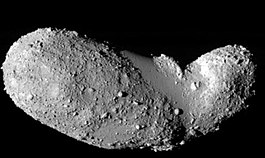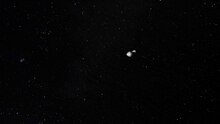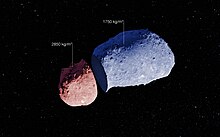25143 Itokawa
 Greyscale (black & white) image of 25143 Itokawa as observed by JAXA's Hayabusa | |
| Discovery [1] | |
|---|---|
| Discovered by | LINEAR |
| Discovery site | Lincoln Lab's ETS |
| Discovery date | 26 September 1998 |
| Designations | |
| MPC designation | (25143) Itokawa |
Named after | Hideo Itokawa (Japanese rocket scientist)[2] |
Alternative designations | 1998 SF36 |
Minor planet category | Apollo · NEO · PHA [1][3] |
Orbital characteristics [1] | |
Epoch 4 September 2017 (JD 2458000.5) | |
| Aphelion | 1.6951 AU |
| Perihelion | 0.9531 AU |
Semi-major axis | 1.3241 AU |
| Eccentricity | 0.2802 |
Orbital period | 1.52 yr (557 days) |
Mean anomaly | 260.79° |
| Inclination | 1.6215° |
Longitude of ascending node | 69.080° |
Argument of perihelion | 162.81° |
| Earth MOID | 0.0129 AU · 5 LD |
Physical characteristics | |
| Dimensions | 535 × 294 × 209 m[4] mean diameter in meters: 313 m[5] 330 m[1] 350 m[6][7] |
| Mass | (3.51±0.105)×1010 kg[4] (3.58±0.18)×1010 kg[8] |
Mean density | 1.9 ±0.13 g/cm³[4] 7000195000000000000♠1.95±0.14 g/cm³[8] |
Rotation period | 7001120000000000000♠12 h[9] 7001121000000000000♠12.1 h[10] 7001121199999999999♠12.12 h[11] 7001121300000000000♠12.13 h[12] 7001121320000000000♠12.132 h[6][13] 7001121323000000000♠12.1323±0.0002 h[14] 7001121324000000000♠12.1324 h[15] 7001121500000000000♠12.15 h[16] 7001120900000000000♠12.09±0.01 h[17] |
Geometric albedo | 6999230000000000000♠0.23[7] 6999283000000000000♠0.283±0.116[5] 6999360000000000000♠0.36±0.22[18] 0.53[19] |
Spectral type | SMASS = S (IV)[1] · Sqw [20] · S [21] · Q [6] |
Absolute magnitude (H) | 18.61[12] · 18.95 (R)[15] · 19.00[21] · 19.2[1] · 19.48[6][7] · 7001195100000000000♠19.51±0.09[5] · 19.73[22] |
25143 Itokawa (/ˌiːtoʊˈkɑːwə/; Japanese: イトカワ,いとかわ,糸川 [itokaɰa]) is a stony sub-kilometer asteroid, classified as near-Earth object of the Apollo group and potentially hazardous asteroid, that measures approximately 350 meters in diameter. It was the first asteroid to be the target of a sample return mission, the Japanese space probe Hayabusa, and the smallest asteroid photographed and visited by a spacecraft.
Contents
1 Discovery and naming
2 Description
3 Exploration
4 Surface features
4.1 Craters
4.2 Regiones
5 Analysis of particles reported in August 2011
6 See also
7 References
8 Further reading
9 External links
Discovery and naming
The asteroid was discovered in 1998 by the LINEAR project at the Lincoln Laboratory's Experimental Test Site in Socorro, New Mexico. It was given the provisional designation 1998 SF36. This minor planet was named after Hideo Itokawa (1912–1999), a Japanese rocket scientist.[23] The official naming citation was published in the Minor Planet Center on 6 August 2003 (M.P.C. 49281).[24]
Description
Itokawa is an S-type asteroid. Radar imaging by Goldstone in 2001 observed an ellipsoid 630 ± 60 m long and 250 ± 30 m wide.[25][26]
The Hayabusa mission confirmed these findings and also suggested that Itokawa may be a contact binary formed by two or more smaller asteroids that have gravitated toward each other and stuck together. The Hayabusa images show a surprising lack of impact craters and a very rough surface studded with boulders, described by the mission team as a 'rubble pile'.[27] Furthermore, the density of the asteroid is too low for it to be made from solid rock. This would mean that Itokawa is not a monolith but rather a 'rubble pile' formed from fragments that have cohered over time. Based on Yarkovsky–O'Keefe–Radzievskii–Paddack effect measurements, a small section of Itokawa is estimated to have a density of 2.9 g/cm³, whereas a larger section is estimated to have a density of 1.8 g/cm³.[28]
 Animation of 25143 Itokawa orbit Lime: Itokawa ; Blue: Earth; Yellow: Sun; |  Itokawa's orbit |
 Play media
Play mediaThis artist’s impression, based on detailed spacecraft observations, shows the strange peanut-shaped asteroid Itokawa.
Exploration
In 2000, it was selected as the target of Japan's Hayabusa mission. The probe arrived in the vicinity of Itokawa on 12 September 2005 and initially "parked" in an asteroid–Sun line at 20 km (12 mi), and later 7 km (4.3 mi), from the asteroid (Itokawa's gravity was too weak to provide an orbit, so the spacecraft adjusted its orbit around the Sun until it matched the asteroid's). Hayabusa landed on 20 November for thirty minutes, but it failed to operate a device designed to collect soil samples. On 25 November, a second landing and sampling sequence was attempted. The sample capsule was returned to Earth and landed at Woomera, South Australia on 13 June 2010, around 13:51 UTC (23:21 local). On 16 November 2010, the Japan Aerospace Exploration Agency reported that dust collected during Hayabusa's voyage was indeed from the asteroid.[29]
Surface features
Names of major surface features were proposed by Hayabusa scientists and accepted by the Working Group for Planetary System Nomenclature of the International Astronomical Union. Also, the Hayabusa science team is using working names for smaller surface features.[30][31] The following tables list the names of geological features on the asteroid.[32] No naming conventions have been disclosed for surface features on Itokawa.
Craters
| Crater | Coordinates | Diameter (km) | Approval Year | Eponym | Ref |
|---|---|---|---|---|---|
| Catalina | 17°S 14°E / 17°S 14°E / -17; 14 (Catalina) | 0.02 | 2009 | Catalina Station (astronomical observatory) in Arizona, United States | WGPSN |
| Fuchinobe | 34°N 91°W / 34°N 91°W / 34; -91 (Fuchinobe) | 0.04 | 2009 | Fuchinobe in Sagamihara, Japan | WGPSN |
| Gando | 76°S 155°W / 76°S 155°W / -76; -155 (Gando) | n.a. | 2009 | Gando, Canary Islands; Spanish launch facility | WGPSN |
| Hammaguira | 18°S 155°W / 18°S 155°W / -18; -155 (Hammaguira) | 0.03 | 2009 | Hammaguir, Algeria; abandoned French launch site and missile testing range in the Sahara desert | WGPSN |
| Kamisunagawa | 28°S 45°E / 28°S 45°E / -28; 45 (Kamisunagawa) | 0.01 | 2009 | Kamisunagawa, town in Hokkaido Japan, where a microgravity test facility is located | WGPSN |
| Kamoi | 6°N 116°W / 6°N 116°W / 6; -116 (Kamoi) | 0.01 | 2009 | Japanese town of Kamoi in Yokohama, location of the NEC TOSHIBA Space Systems Ltd. factory | WGPSN |
| Komaba | 10°S 102°E / 10°S 102°E / -10; 102 (Komaba) | 0.03 | 2009 | Komaba in Meguro, Japan, where the Institute of Space and Astronautical Science is located | WGPSN |
| Laurel | 1°N 162°E / 1°N 162°E / 1; 162 (Laurel) | 0.02 | 2009 | U.S. city of Laurel in Maryland, where APL/JHU is located | WGPSN |
| Miyabaru | 40°S 116°W / 40°S 116°W / -40; -116 (Miyabaru) | 0.09 | 2009 | Radar site of the Uchinoura Space Center in Japan | WGPSN |
| San Marco | 28°S 41°W / 28°S 41°W / -28; -41 (San Marco) | n.a. | 2009 | San Marco platform, an old oil platform near Kenya that served as a launch pad for Italian spacecraft | WGPSN |
Regiones
Regiones (geologically distinct areas) on Itokawa.
| Regio | Named after |
|---|---|
| Arcoona Regio | Arcoona, Australia |
| LINEAR Regio | Lincoln Near-Earth Asteroid Research |
| MUSES-C Regio | MUSES-C, name of the Hayabusa probe prior to launch. |
| Ohsumi Regio | Ōsumi Peninsula |
| Sagamihara Regio | Sagamihara, a town in Japan where Institute of Space and Astronautical Science is located. |
| Uchinoura Regio | Uchinoura, a town in Japan (now part of Kimotsuki), the location of Uchinoura Space Center, Hayabusa launch site. |
| Yoshinobu Regio | Launch site in the Tanegashima Space Center, Japan. |
Analysis of particles reported in August 2011

Schematic view of 25143 Itokawa[33]
The 26 August 2011 issue of Science devoted six articles to findings based on dust that Hayabusa had collected from Itokawa.[34] Scientists' analysis suggested that Itokawa was probably made up from interior fragments of a larger asteroid that broke apart.[35] Dust collected from the asteroid surface is thought to have been exposed there for about eight million years.[34]
Scientists used varied techniques of chemistry and mineralogy to analyze the dust from Itokawa.[35] Itokawa's composition was found to match the common type of meteorites known as "low-total-iron, low metal ordinary chondrites".[36] Another team of scientists determined that the dark iron color on the surface of Itokawa was the result of abrasion by micrometeoroids and high-speed particles from the Sun which had converted the normally whitish iron oxide coloring.[36]
See also
- (341843) 2008 EV5
References
^ abcdef "JPL Small-Body Database Browser: 25143 Itokawa (1998 SF36)" (2016-01-24 last obs.). Jet Propulsion Laboratory. Retrieved 15 August 2017..mw-parser-output cite.citation{font-style:inherit}.mw-parser-output q{quotes:"""""""'""'"}.mw-parser-output code.cs1-code{color:inherit;background:inherit;border:inherit;padding:inherit}.mw-parser-output .cs1-lock-free a{background:url("//upload.wikimedia.org/wikipedia/commons/thumb/6/65/Lock-green.svg/9px-Lock-green.svg.png")no-repeat;background-position:right .1em center}.mw-parser-output .cs1-lock-limited a,.mw-parser-output .cs1-lock-registration a{background:url("//upload.wikimedia.org/wikipedia/commons/thumb/d/d6/Lock-gray-alt-2.svg/9px-Lock-gray-alt-2.svg.png")no-repeat;background-position:right .1em center}.mw-parser-output .cs1-lock-subscription a{background:url("//upload.wikimedia.org/wikipedia/commons/thumb/a/aa/Lock-red-alt-2.svg/9px-Lock-red-alt-2.svg.png")no-repeat;background-position:right .1em center}.mw-parser-output .cs1-subscription,.mw-parser-output .cs1-registration{color:#555}.mw-parser-output .cs1-subscription span,.mw-parser-output .cs1-registration span{border-bottom:1px dotted;cursor:help}.mw-parser-output .cs1-hidden-error{display:none;font-size:100%}.mw-parser-output .cs1-visible-error{font-size:100%}.mw-parser-output .cs1-subscription,.mw-parser-output .cs1-registration,.mw-parser-output .cs1-format{font-size:95%}.mw-parser-output .cs1-kern-left,.mw-parser-output .cs1-kern-wl-left{padding-left:0.2em}.mw-parser-output .cs1-kern-right,.mw-parser-output .cs1-kern-wl-right{padding-right:0.2em}
^ Schmadel, Lutz D. (2006). Dictionary of Minor Planet Names – (25143) Itokawa, Addendum to Fifth Edition: 2003–2005. Springer Berlin Heidelberg. p. 188. ISBN 978-3-540-34361-5. Retrieved 15 August 2017.
^ "25143 Itokawa (1998 SF36)". Minor Planet Center. Retrieved 15 August 2017.
^ abc Akira Fujiwara, et al., The Rubble-Pile Asteroid Itokawa as Observed by Hayabusa, Science, Vol. 312. no. 5778, pp. 1330 – 1334, 2 June 2006
^ abc Mueller, Michael; Delbo', M.; Hora, J. L.; Trilling, D. E.; Bhattacharya, B.; Bottke, W. F.; et al. (April 2011). "ExploreNEOs. III. Physical Characterization of 65 Potential Spacecraft Target Asteroids". The Astronomical Journal. 141 (4): 9. Bibcode:2011AJ....141..109M. doi:10.1088/0004-6256/141/4/109. Retrieved 15 August 2017.
^ abcd "LCDB Data for (25143) Itokawa". Asteroid Lightcurve Database (LCDB). Retrieved 15 August 2017.
^ abc Sekiguchi, T.; Abe, M.; Boehnhardt, H.; Dermawan, B.; Hainaut, O. R.; Hasegawa, S. (January 2003). "Thermal observations of MUSES-C mission target (25143) 1998 SF36". Astronomy and Astrophysics: 325–328. Bibcode:2003A&A...397..325S. doi:10.1051/0004-6361:20021437. Retrieved 15 August 2017.
^ ab Shinsuke Abe, et al., Mass and Local Topography Measurements of Itokawa by Hayabusa, Science, Vol. 312. no. 5778, pp. 1344 – 1347, 2 June 2006
^ Lambert, J. S.; Tholen, D. J. (December 2001). "Rotational Studies of MUSES-C Target Asteroid (25143) 1998 SF36". American Astronomical Society. 33: 1402. Bibcode:2001AAS...199.6303L. Retrieved 15 August 2017.
^ Lowry, S. C.; Weissman, P. R.; Hicks, M. D. (November 2001). "CCD Observations of Asteroid 1998 SF36 (25143)". American Astronomical Society. 33: 1150. Bibcode:2001DPS....33.5909L. Retrieved 15 August 2017.
^ Lowry, Stephen C.; Weissman, Paul R.; Hicks, Michael D.; Whiteley, Robert J.; Larson, Steve (August 2005). "Physical properties of Asteroid (25143) Itokawa—Target of the Hayabusa sample return mission". Icarus. 176 (2): 408–417. Bibcode:2005Icar..176..408L. doi:10.1016/j.icarus.2005.02.002. Retrieved 15 August 2017.
^ ab Dermawan, Budi; Nakamura, Tsuko; Fukushima, Hideo; Sato, Hideo; Yoshida, Fumi; Sato, Yusuke (August 2002). "CCD Photometry of the MUSES-C Mission Target: Asteroid (25143) 1998 SF36". Publications of the Astronomical Society of Japan. 54 (4): 635–640. Bibcode:2002PASJ...54..635D. doi:10.1093/pasj/54.4.635. Retrieved 15 August 2017.
^ Kaasalainen, M.; Kwiatkowski, T.; Abe, M.; Piironen, J.; Nakamura, T.; Ohba, Y.; et al. (July 2003). "CCD photometry and model of MUSES-C target (25143) 1998 SF36". Astronomy and Astrophysics: L29–L32. Bibcode:2003A&A...405L..29K. doi:10.1051/0004-6361:20030819. Retrieved 15 August 2017.
^ Durech, J.; Vokrouhlický, D.; Kaasalainen, M.; Weissman, P.; Lowry, S. C.; Beshore, E.; et al. (September 2008). "New photometric observations of asteroids (1862) Apollo and (25143) Itokawa – an analysis of YORP effect". Astronomy and Astrophysics. 488 (1): 345–350. Bibcode:2008A&A...488..345D. doi:10.1051/0004-6361:200809663. Retrieved 15 August 2017.
^ ab Nishihara, S.; Abe, M.; Hasegawa, S.; Ishiguro, M.; Kitazato, K.; Miura, N.; et al. (March 2005). "Ground-based Lightcurve Observation of (25143) Itokawa, 2001–2004". 36th Annual Lunar and Planetary Science Conference. Bibcode:2005LPI....36.1833N. Retrieved 15 August 2017.
^ Ohba, Y.; Abe, M.; Hasegawa, S.; Ishiguro, M.; Kwiatkowski, T.; Colas, F.; et al. (June 2003). "Pole orientation and triaxial ellipsoid shape of (25143) 1998 SF36, a target asteroid of the MUSES-C* mission". Earth. 55: 341–347.(EP&SHomepage). Bibcode:2003EP&S...55..341O. Retrieved 15 August 2017.
^ Warner, Brian D. (September 2004). "Lightcurve analysis for numbered asteroids 301, 380, 2867, 8373, 25143, and 31368". The Minor Planet Bulletin. 31 (3): 67–70. Bibcode:2004MPBu...31...67W. ISSN 1052-8091. Retrieved 15 August 2017.
^ Thomas, C. A.; Trilling, D. E.; Emery, J. P.; Mueller, M.; Hora, J. L.; Benner, L. A. M.; et al. (September 2011). "ExploreNEOs. V. Average Albedo by Taxonomic Complex in the Near-Earth Asteroid Population". The Astronomical Journal. 142 (3): 12. Bibcode:2011AJ....142...85T. doi:10.1088/0004-6256/142/3/85. Retrieved 15 August 2017.
^ S. M. Lederer, et al., Physical characteristics of Hayabusa target Asteroid 25143 Itokawa, Icarus, v. 173, p. 153–165 (2005)
^ Thomas, Cristina A.; Emery, Joshua P.; Trilling, David E.; Delbó, Marco; Hora, Joseph L.; Mueller, Michael (January 2014). "Physical characterization of Warm Spitzer-observed near-Earth objects". Icarus. 228: 217–246. arXiv:1310.2000. Bibcode:2014Icar..228..217T. doi:10.1016/j.icarus.2013.10.004. Retrieved 15 August 2017.
^ ab Carry, B.; Solano, E.; Eggl, S.; DeMeo, F. E. (April 2016). "Spectral properties of near-Earth and Mars-crossing asteroids using Sloan photometry". Icarus. 268: 340–354. arXiv:1601.02087. Bibcode:2016Icar..268..340C. doi:10.1016/j.icarus.2015.12.047. Retrieved 15 August 2017.
^ Abe, M.; Ohba, Y.; Ishiguro, M.; Hasegawa, S.; Fuse, T.; Aoki, K.; et al. (March 2002). "Physical Model and Taxonomic Type of 1998 SF36, the Target Asteroid of Sample Return Mission, MUSES-C". 33rd Annual Lunar and Planetary Science Conference. Bibcode:2002LPI....33.1666A. Retrieved 15 August 2017.
^ "Official Approval of Names on ITOKAWA by IAU". Press Release of JAXA. 3 March 2009.
^ "MPC/MPO/MPS Archive". Minor Planet Center. Retrieved 15 August 2017.
^ Ostro, S. J.; Benner, L. A. M.; Nolan, M. C.; Giorgini, J. D.; Jurgens, R. F.; Rose, R.; Yeomans, D. K. (2001). "Radar Observations of Asteroid 25143 (1998 SF36)". Bulletin of the American Astronomical Society. 33: 1117. Bibcode:2001DPS....33.4113O.
^ "Radar Observations of Asteroid 25143 Itokawa (1998 SF36)" (PDF). Archived (PDF) from the original on 8 April 2015. Retrieved 8 April 2015.
^
"Hayabusa: Itokawa Beckons as Japan's Spacecraft Searches for Places to Touch Down". Archived from the original on 12 May 2008. Retrieved 11 August 2008.CS1 maint: BOT: original-url status unknown (link)
^ "The Anatomy of an Asteroid". ESO. 5 February 2014. Retrieved 5 February 2014.
^ Atkinson, Nancy (16 November 2010). "Confirmed: Hayabusa Nabbed Asteroid Particles". Universe Today. Archived from the original on 6 December 2010. Retrieved 16 November 2010.
^
"Itowaka Geological Map". Archived from the original on 26 February 2009. Retrieved 11 August 2008.CS1 maint: BOT: original-url status unknown (link)
^
"Local site names on Itowaka". Archived from the original on 26 February 2009. Retrieved 11 August 2008.CS1 maint: BOT: original-url status unknown (link)
^ USGS: Itokawa nomenclature
^ "The Anatomy of an Asteroid". ESO Press Release. Retrieved 6 February 2014.
^ ab "Asteroid Dust Confirms Meteorite Origins". New York Times. 25 August 2011. Retrieved 26 August 2011.
^ ab Nakamura, Tomoki; Noguchi, Takaaki; Tanaka, Masahiko; Zolensky, Michael E.; Kimura, Makoto; Tsuchiyama, Akira; Nakato, Aiko; Ogami, Toshihiro; Ishida, Hatsumi; Uesugi, Masayuki; Yada, Toru; Shirai, Kei; Fujimura, Akio; Okazaki, Ryuji; Sandford, Scott A.; Ishibashi, Yukihiro; Abe, Masanao; Okada, Tatsuaki; Ueno, Munetaka; Mukai, Toshifumi; Yoshikawa, Makoto; Kawaguchi, Junichiro (26 August 2011). "Itokawa Dust Particles: A Direct Link Between S-Type Asteroids and Ordinary Chondrites". Science. 333 (6046): 1113–6. Bibcode:2011Sci...333.1113N. doi:10.1126/science.1207758. PMID 21868667. Retrieved 26 August 2011.
^ ab "Most Earth meteorites linked to single asteroid". Los Angeles Times. 26 August 2011. Retrieved 26 August 2011.
Further reading
Durech, J.; Vokrouhlický, D.; Kaasalainen, M.; Weissman, P.; Lowry, S. C.; Beshore, E.; Higgins, D.; Krugly, Y. N.; et al. (September 2008). "New photometric observations of asteroids (1862) Apollo and (25143) Itokawa – an analysis of YORP effect" (PDF). Astronomy and Astrophysics. 488 (1): 345–350. Bibcode:2008A&A...488..345D. doi:10.1051/0004-6361:200809663.
Normile, D (30 April 2010). "Spunky Hayabusa Heads Home With Possible Payload". Science. 328 (5978): 565. Bibcode:2010Sci...328..565N. doi:10.1126/science.328.5978.565. PMID 20430991.
External links
| Wikimedia Commons has media related to 25143 Itokawa. |
Hayabusa's Scientific and Engineering Achievements during Proximity Operations around Itokawa (JAXA press release)- Gazetteer of Planetary Nomenclature
MIT's LINEAR asteroid named for Japan's 'Dr. Rocket' (MIT press release)- JAXA Hayabusa official page
Earth impact probability of the Asteroid (25143) Itokawa to be sampled by the spacecraft Hayabusa (paper abstract)- Astronomy Picture Of The Day: Approaching Asteroid Itokawa, A Robot's Shadow on Asteroid Itokawa, The Missing Craters of Asteroid Itokawa, Smooth Sections on Asteroid Itokawa
Special issue: Hayabusa at Itokawa, Science, Vol. 312, no. 5778, 2 June 2006
Lightcurve plot of 25143 Itokawa, Palmer Divide Observatory, B. D. Warner (2004)
Initial Scientific Results of Hayabusa’s Investigation on Itokawa ~Summary of the Special Issue of "Science"Magazine~ (ISAS/JAXA press release)
Hot Topic: Hayabusa—Dust from Itokawa, Science, Vol. 333, no. 6046, 26 August 2011- Animated model of Itokawa rotating (in anaglyph form for use with red-blue glasses)
Itokawa in enhanced color (From this presentation)
25143 Itokawa at the JPL Small-Body Database
Close approach · Discovery · Ephemeris · Orbit diagram · Orbital elements · Physical parameters